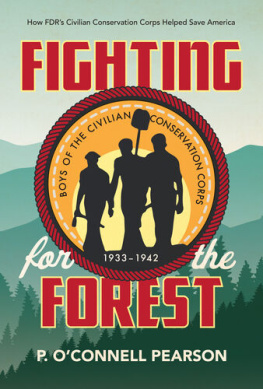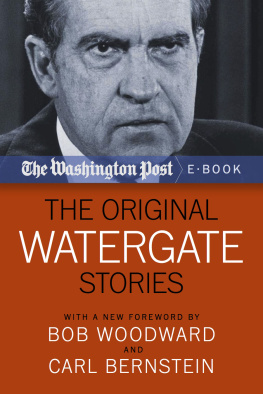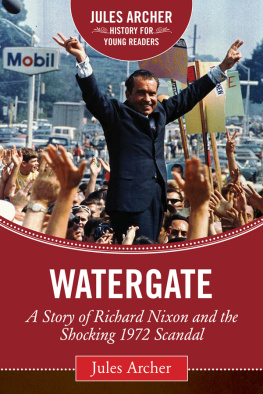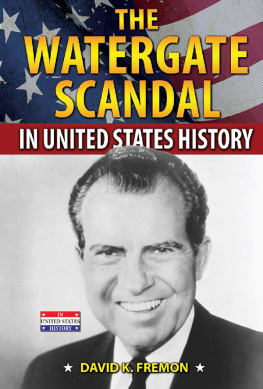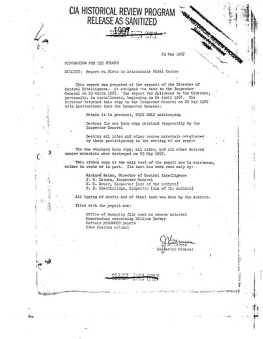THE REAL WATERGATE SCANDAL

Copyright 2015 by Geoff Shepard
All rights reserved. No part of this publication may be reproduced or transmitted in any form or by any means electronic or mechanical, including photocopy, recording, or any information storage and retrieval system now known or to be invented, without permission in writing from the publisher, except by a reviewer who wishes to quote brief passages in connection with a review written for inclusion in a magazine, newspaper, website, or broadcast.
Regnery History is a trademark of Salem Communications Holding Corporation; Regnery is a registered trademark of Salem Communications Holding Corporation
First e-book edition 2015: 978-1-62157-386-9
Originally published in hardcover, 2015: 978-1-62157-328-9
The Library of Congress has cataloged the hardcover edition as follows:
Shepard, Geoffrey Carroll, 1944-
The real Watergate scandal : collusion, conspiracy, and the plot that brought Nixon down / Geoff Shepard.
pages cm
ISBN 978-1-62157-328-9
1. Watergate Affair, 1972-1974. 2. Nixon, Richard M. (Richard Milhous), 1913-1994. 3. United States--Politics and government--1969-1974. 4. Conspiracies--United States--History--20th century. I. Title.
E860.S529 2015
973.924--dc23
2015012716
Distributed to the trade by
Perseus Distribution
250 West 57th Street
New York, NY 10107
Manufactured in the United States of America
10 9 8 7 6 5 4 3 2 1
Books are available in quantity for promotional or premium use.
For information on discounts and terms, please visit our website: www.Regnery.com.
Published in the United States by
Regnery History
An imprint of Regnery Publishing
A Division of Salem Media Group
300 New Jersey Ave NW
Washington, DC 20001
www.RegneryHistory.com
To the outstanding group of men and women who served honorably and with distinction in the Nixon administration

Prudhons Justice and Divine Vengeance Pursuing Crime
CONTENTS
MY ROLE
I was there, in the room, at the very moment Richard Nixons Watergate defense collapsed. It was a Monday afternoon, July 26, 1974, just hours after the Supreme Court had upheld the special prosecutors subpoena for sixty-four more White House tape recordings. Fred Buzhardt, special counsel to the president and Nixons principal defense lawyer, had been directed to review one conversation in particular. It had taken place on June 23, 1972, just six days after the Watergate burglary arrests. Soon known as the smoking gun, it revealed Nixon concurring with his staffs recommendation that they get the CIA to tell the FBI to limit its Watergate investigation. Nixon could not explain the tape, and Buzhardt had no reason to think it was anything other than confirmation that the president himself had authorized an obstruction of justice within a week of the Watergate arrests.
On that Monday afternoon, Buzhardt telephoned Nixon and his chief of staff, Alexander Haig, and told them what he had heard on the June 23 tape. With no explanation forthcoming and bound by the Courts ruling, the presidents lawyers quickly concluded they could no longer support his efforts to avoid impeachment. Left alone and defenseless, the Nixon presidency quickly collapsed.
I was in Buzhardts office during that conversation and remember it as vividly as if it were yesterday. As soon as it ended, I became the third person to hear that key tape. I was the one who prepared its official transcript and the one who named it the smoking gun.
One of Watergates great ironies is that we all misinterpreted that recorded conversation. John Dean, President Nixons principal accuser, has recently acknowledged that the president and his defense team were totally mistaken about that tape and its significance. If we had known the context in which that conversation had taken place, the president would not have had to resign and, in Deans own words, could have lived to fight another day.
But resign he did, just four days following the tapes public release. I was in the East Room of the White House when he bid his staff adieu and on the South Lawn when his helicopter lifted off for the last time. It was the saddest day of my life, but my association with Richard Nixon neither started nor ended with Watergate.

It is as though I have been living in Nixons shadow since I came of age, and happily so. Readers deserve to know this background, so they can properly appreciate the analysis and disclosures that follow.
I was Nixons junior by some thirty years. Like him, I was born and raised in Southern California. I know what it is like to have grown up far from the liberal Eastern establishment in what was then the cultural backwater of greater Los Angeles. I first heard Nixon speak in 1960, when he was running for president, at something called the Iowa Picnic in Long Beach. So many people from the Hawkeye state had moved to the area in the 1930s and 40s that it was known as Iowa by the Sea, and their annual picnic was a huge social affair. A junior at Woodrow Wilson High School, Id been assigned to write a paper on Nixons speech. I dont remember much of what he said, but I do recall my disappointment that he talked more about his familys Iowa connections than about the weighty issues of the day. It made it tough to write my report.
Our paths crossed again five years later at a scholarship luncheon given by the Republican Womens Club of Whittier, California. Now a junior at Whittier College, Nixons alma mater, I had just been elected student body president and had won the Richard Nixon scholarshipworth $250, not an insignificant sum in those days to a struggling student. Since that speech at the Iowa Picnic, Nixon had lost the 1960 presidential race to John Kennedy and the 1962 California gubernatorial race to Pat Brown. He had decided to quit politics for good and relocated to New York City to practice law. He was loyal to Whittier College but hadnt come all that way just to present my award. Having arranged for Bob Hope to be Whittiers commencement speaker that year, Nixon came for the graduation ceremony. To everyones pleasant surprise, the former vice president also came to the ladies luncheon, and I was seated next to him. We talked about our respective college experiences, he gave a nice speech about how much Whittier meant to him, and we parted ways. The following week I learned that Nixon, upon returning to New York, had personally doubled my scholarship. Money was tight in those days, and even after fifty years I still consider myself indebted to him for his generosity.
The following year, I was off to Harvard Law School (again on scholarship), and Nixon was off to pursue the presidency. Somewhere in my files, I still have the homemade campaign badge that says Nixon Shepard, as though I were his running mate. After all, I had made no secret to my Harvard classmates about my hopes to be a part of his administration, should he be victorious.
He was and so was I. A month after Nixons victory, at the ripe age of twenty-four, I applied to be a White House Fellow. I ended up being among the youngest ever chosen for that outstanding program, which is essentially a year-long seminar on how the federal government functions. I spent my fellowship year working at the Treasury Department for Paul Volcker, then the undersecretary for monetary affairs. At its conclusion, I landed a much coveted position on John Ehrlichmans White House Domestic Council staff, where I stayed for five years and eventually became associate director for general government.
Next page

